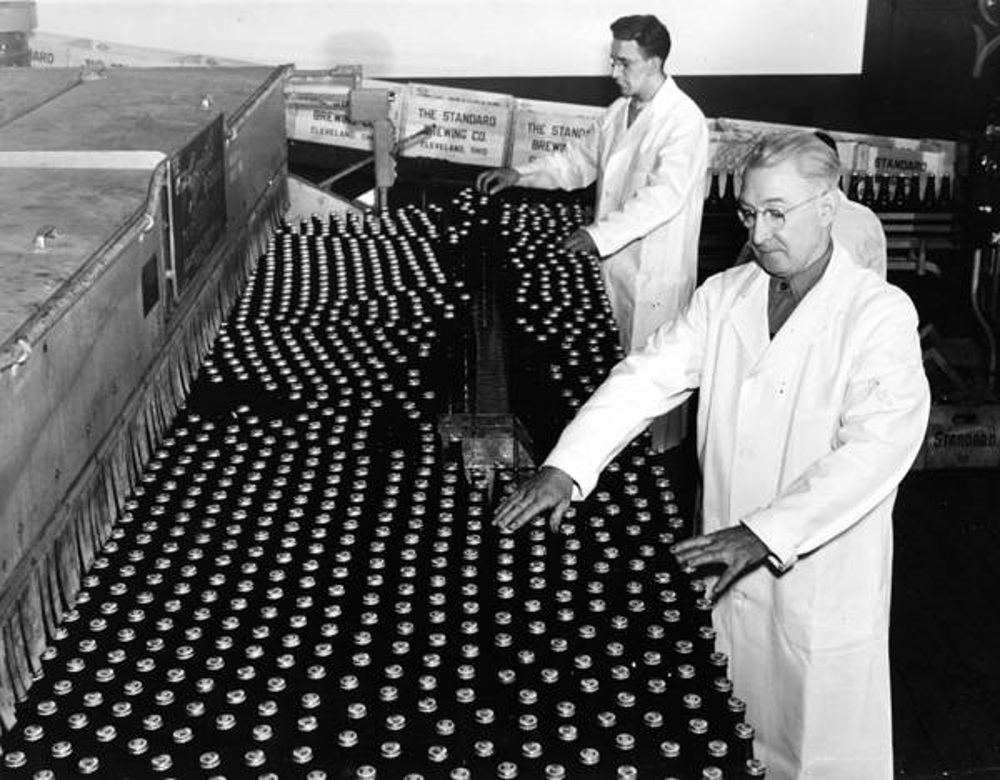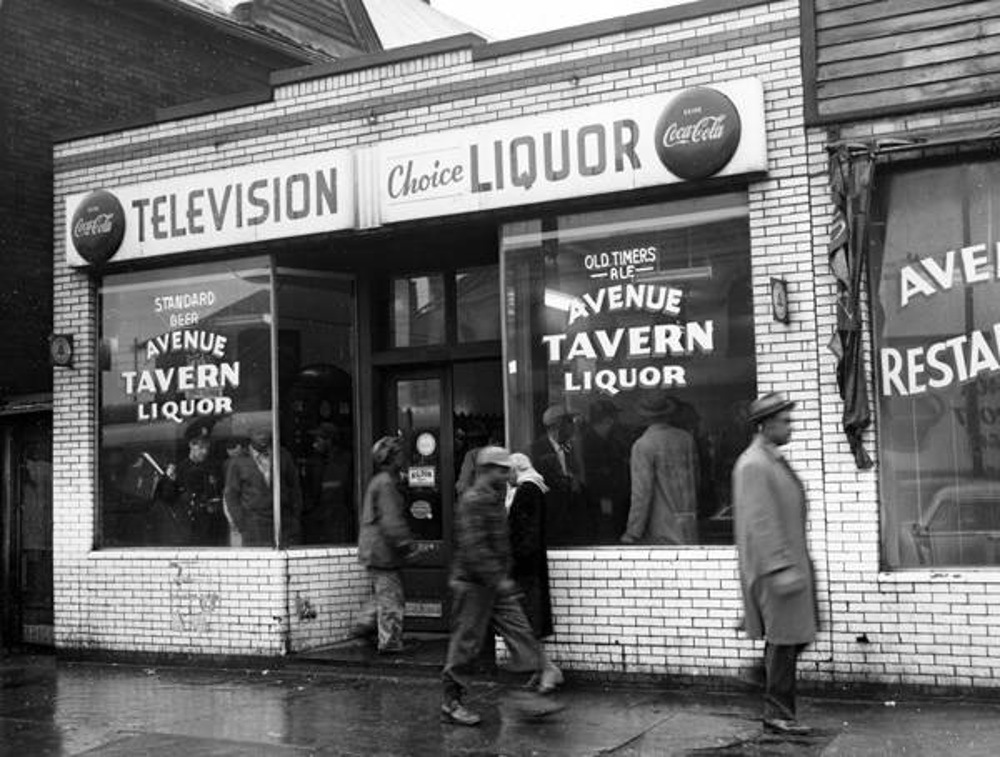
When the Standard Brewing Company sponsored the TV and radio broadcasts of Cleveland Indians games in 1948 (the year the Tribe last won the World Series), the company's Erin Brew beer, for decades a favorite in the city's Irish-American community, suddenly became one of the most popular beers in all of Cleveland.
Train Avenue on the west side of Cleveland is undoubtedly so named because it follows the tracks of the Big Four Railroad in a northeasterly direction from the old Stockyards near Clark Avenue and West 61st Street almost all the way to the Cuyahoga River. If you travel to Train Avenue's western end today, you'll see on the south side of the street—just before you get to the West 61st Street intersection—several old red brick buildings. Near the top of one are two granite stones, one carved with the word "Bottle" and the other with "Works." On the building next to that, you'll see another granite stone, this one carved with the year "1913." Whether you're a beer lover or not, give yourself a pat on the back, for you have just arrived at the place where the Standard Brewing Company once manufactured Erin Brew beer—one of the most popular beers in the history of Cleveland.
The Standard Brewing Company had its origins in the founding of the Kress-Weiss Brewing Company in 1902. In that year, Stephen S. Creadon, a west side saloonkeeper and second generation Irish-American, entered into an agreement with German immigrant brewer Andrew Kress and several investors to produce a weiss (light wheat) beer out of an old butcher shop located on the corner of Sackett and Louis (West 32nd) Streets, in today's Clark-Fulton neighborhood. Unfortunately, the venture faltered, and Creadon and Kress soon parted ways. In 1904, Creadon, who retained the lease to the brewery building, brought in new investors and Jaroslav Pavlik, a Czech immigrant brewer, and incorporated anew under the name of the Standard Brewing Company. Pavlik brewed lager beer—darker and heavier than weiss beer—and sales quickly took off. The following year, the growing firm recapitalized and moved to a larger facility, an old flour mill located on the north side of Train Avenue near the West 61st street intersection.
Just one year after moving to its new location, the young company faced a serious challenge to its continued existence. In November 1906, J. P. Kraus, a banker with First National Bank which had financed the new venture and controlled most of the company's stock, proposed that its directors approve a sale of their business to Cleveland and Sandusky Brewing Company. The latter was a large regional brewery which had been gobbling up local independent breweries in the Cleveland and Sandusky areas since 1897. Standard Brewing's directors—led by Creadon, whose experiences as a saloon keeper had perhaps persuaded him to stay away from conglomerates—voted to stay independent and rejected the proposed sale. However, Creadon now had to find new financing for his company and find it quickly. His search ended with John T. Feighan, a Forest City Savings and Trust Company banker, who, like Creadon, was a member of the west side Irish community. Feighan's bank, which since 1903 had been located in a new building on the southwest corner of Pearl (West 25th) Street and Detroit Avenue, was right across the street from Creadon's other business—his neighborhood saloon. Soon Feighan became not only a lender and director of Standard Brewing, but also an officer of the company, serving first as its treasurer and then later as its president after Creadon's death in 1921.
Creadon's savvy in the saloon business, Feighan's business acumen, and Pavlik's brewing skills: They were a winning combination. By 1913, new brewery buildings had gone up on both the north and south sides of Train Avenue and the company was now marketing Pavlik's lager under the name of Erin Brew, making it a favorite among Cleveland's west side Irish-American community. According to the company's 1914 corporate report, between the years 1906 and 1913 it almost doubled production, increasing annual output from 40,000 barrels to 75,000 in that period. As it approached the end of that decade, Standard Brewing Company had become one of Cleveland's largest and most successful independent breweries. Then, in 1919, the State of Ohio banned the sale and manufacture of liquor within the state, and one year after that the Eighteenth Amendment to the U.S. Constitution was passed, ushering in the era of national Prohibition. Standard Brewing Company, like several other Cleveland breweries that survived Prohibition, converted its manufacturing facilities to the production of ginger ale and other soft drinks. When Prohibition ended in 1933, those breweries were able to quickly shift production back to beer. By May of that year, Standard Brewing Company was once again producing Erin Brew beer for a very thirsty consumer public.
In the 1940s, just after the end of World War II, Standard Brewing Company, under the leadership of John T. Feighan and George Creadon, son of founder Stephen Creadon, entered into a series of annual agreements to sponsor radio and TV broadcasts of Cleveland Indians baseball games. When the Indians won the World Series in 1948, Erin Brew beer went from being the favorite beer of Cleveland's Irish community to being one of the most loved beers in all of Cleveland. Responding to this increased demand, in 1950 the company built an extensive new bottling and canning facility just west of its earlier twentieth-century buildings on Train Avenue. Sadly, this would be the peak of Standard Brewing Company's successful operations in Cleveland.
The decade of the 1950s marked the beginning of the end for Cleveland's brewing industry, as a changing consumer public and improved transportation facilities promoted the success of large national breweries at the expense of smaller local breweries. Standard Brewing Company was one of the last of Cleveland's independent breweries to succumb, selling its brewery facilities to the F & M Schaefer Brewing Company of New York in 1961. Three years after that, Schaefer sold the facilities to C. Schmidt & Sons Inc., a large Philadelphia brewery. By the mid-1960s, Erin Brew was replaced by Standard Premium and soon the once most popular beer in Cleveland was just a memory.
Images













